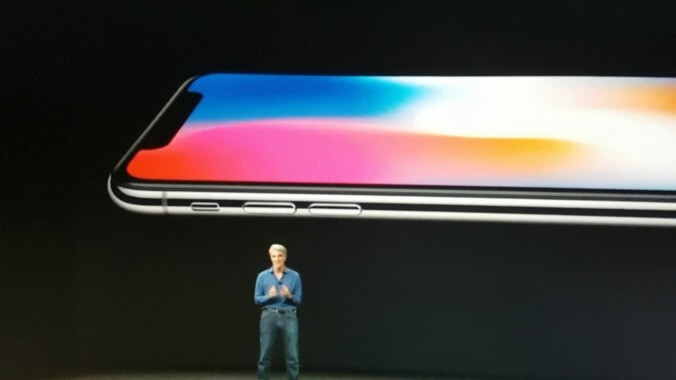Apple introduces its first insanely expensive iPhone

A decade after the late Steve Jobs introduced the world to the original iPhone, Apple’s Tim Cook today unveiled the latest updates to a world filled with people too busy staring at their iPhone to listen. The new iPhone 8 has plenty of attractive features that you will nod perfunctorily at as they are rattled off by an Apple Store employee who’s just informed you that fixing your perfectly good iPhone will cost nearly as much as getting a new one: a new A11 Bionic 64-bit processor, a slightly better camera, and most importantly, Qi wireless charging. But while this $699 phone is okay for everyday use while camping or working at the cannery or for deterring thieves, for an iPhone that conveys that you enjoy the finer things in life, look no further than the iPhone X—Apple’s first incredibly expensive phone.
While the ownership of a “premium tier” smartphone is obviously its own reward, the 10th-anniversary iPhone X also has a few features that lift it above the grotesque, Rabelaisian muck of the iPhone 8 and its predecessors. In addition to the aforementioned wireless charging, which necessitates a glass back, the entire front is glass as well—glass that spreads seamlessly to every edge of its massive, bezel-less screen. Some have already expressed concern that making the entire iPhone out of glass, which has a tendency to break like glass, could lead to twice the risk of cracking. But Cook reassures them that these glass panels are reinforced by internal steel and “the most durable glass ever in a smartphone,” and besides, there shouldn’t be any cracking at all if properly lifted in and out of its velvet coffer by your valet.
In addition to twice the opportunity for damage to inject minor thrill into your idle ennui, the iPhone X also has some other exciting features, like the previously rumored complete absence of a Home button. Let the plebes stab their chicken grease-coated stubs on a physical button; you will swipe. To return to the home screen, you will swipe up from the bottom. To access the multitasking pane, swipe up from the button and pause. To feel alive, you will swipe, your fingers lightly tracing delicate minuets around and around your enormous glass screen, graceful as a swan who’s in no particular rush to back out of an unresponsive app.
